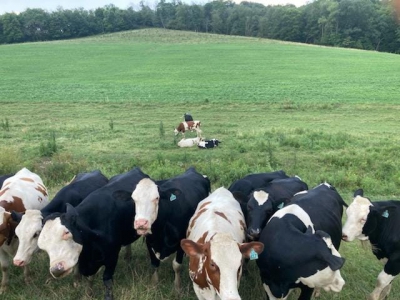Cows of a different color: Hybrids let dairy farmers produce milk with fewer resources

Some local dairy herds are changing color and getting shorter. That's a good thing, according to a man who consults with area dairy farms.
Starting in 1999, the concept pioneers tried, and discarded, multiple breeds of cows to reach the ideal prototype animals. Photo: Glenn Carlisle
Glenn Carlisle, of Carlisle Dairy + Forage Consulting, LLC, of Dover, is among those promoting planned three-way cross breeding of dairy cattle to allow farmers to get more income while using fewer resources to produce milk.
"Beef, poultry and swine have utilized three-way hybrids ever since I can remember," Carlisle said, citing these benefits:
Increased feed efficiency, with cross-breeds requiring 10% to 15% less feed per unit of production.
Higher fertility, which lowers health-intervention costs.
Longevity, a bonus from breeding the right animals with each other.
"The concept was developed and extensively researched by a group of California dairymen along with an innovative cow breeding expert named Mike Osmundson," Carlisle said. "Starting in 1999, the concept pioneers tried, and discarded, multiple breeds of cows to reach the ideal prototype animals."
He said black-and-white, pure-bred Holstein-Friesian cows have dominated world milk production for over 100 years. Along the way, some strengths were shed to achieve higher production. Lower productive lifetimes with higher health intervention costs, and an issue with in-breeding closely related cows, have inadvertently caused some issues that cost the farmers significant losses of income.
Talk about inbreeding
How inbred are they?
Carlisle noted that 90% of purebred Holsteins are descended from six sires.
Researchers settled on two breeds to complement the Holstein drive to produce large amounts of milk. They are the Montebeliarde from France, a durable, fertile and low- input breed, and the VikingRed, a hardy cow developed in the Nordic countries which has minimal health issues and high fertility.
"The resulting off-spring are an interesting variety of color patterns, but uniform in size, and easily achieve the desired goals." Carlisle said. The red coats of the parents show up in succeeding generations. They are shorter in stature than pure U.S. Holsteins.
Carlisle said these multi-colored cows produce milk with denser milk solids: butterfat, protein and other solids.
"As human fluid milk trends continue to drop — and butter, cheese, yogurt and other products consumers want are going sharply upwards in demand — it makes sense in many ways," Carlisle said. "Since a dairyman’s payment for his milk is based on the percentage of these solids in his milk – more income can be produced without increasing the volume of milk transported."
More profit, less stress
The cross-bred cows are more profitable than their Holstein herdmates, according to the report from a 10-year study with high-performance Minnesota dairy herds. The study was conducted by three researchers from the University of Minnesota. The final results of the study were presented in a July 2019 conference in the Netherlands.
"The concept – now called ProCROSS and marketed in the USA by Creative Genetics of California and world-wide — is proving to be a huge financial boon to U.S. farming families by decreasing resources used in feed and labor and increased quality of family life with lower stress," Carlisle said. "That is exciting for me as a consultant to our local family owned farms. Better quality of life with less stress. Who wouldn’t like that?"
Related news
 Winter feed costs dependent on forage prices
Winter feed costs dependent on forage prices Agricultural business specialist Brent Carpenter and livestock specialist Gene Schmitz looked at how current prices affect winter feeding costs for several
 Adapt winter milking routines to keep milk quality high
Adapt winter milking routines to keep milk quality high Start using a post-dip with a higher level of emollients to protect, heal and soften teat skin.
 What does the future hold for UK beef farming?
What does the future hold for UK beef farming? A further shift from suckler- to dairy-bred beef, greater emphasis on carbon credentials and solid demand are the key forecasts for the beef sector.